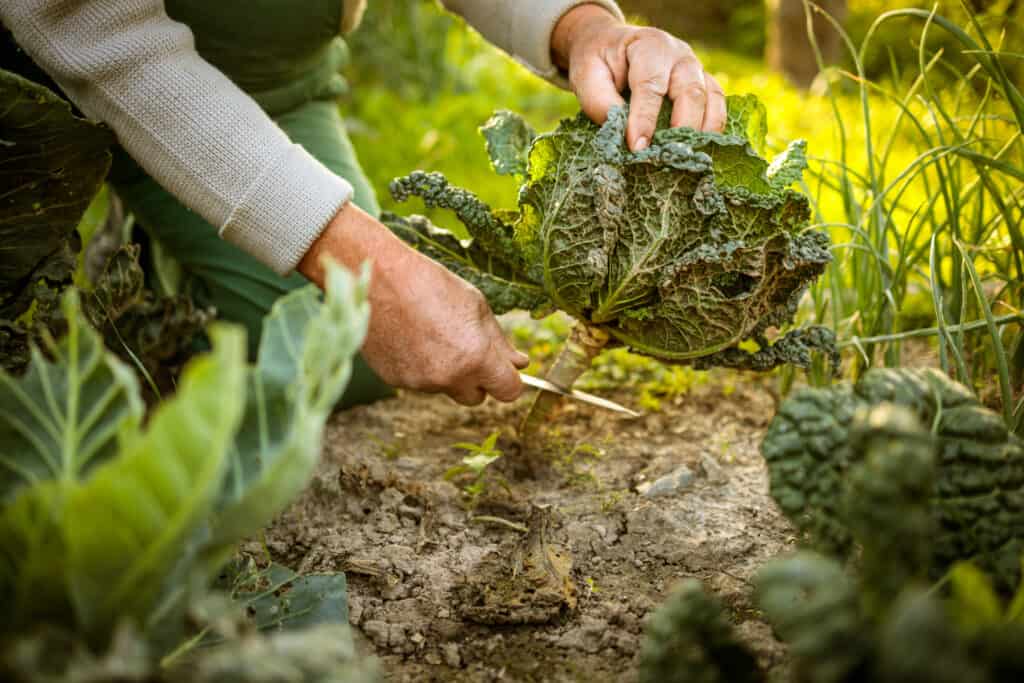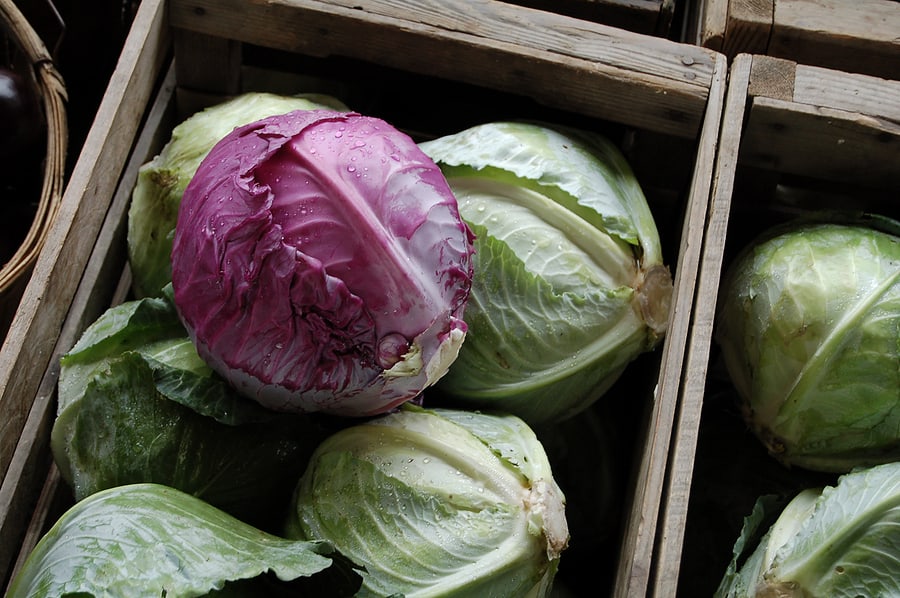Harvest cabbage at any size after the head becomes firm and before it splits. Leave two to four wrapper leaves around the head to keep it from drying.
- Heading cabbage can be harvested when the head is about the size of a softball—5 inches (12 cm) or more across, squeeze it to test firmness.
- Elongated Chinese or Napa cabbage is ready for harvest when the head is 9 to 12 inches (22-30 cm) tall.
- Leafy cabbages—that do not form tight heads—can be harvested leaf-by-leaf about a month after planting; use the cut-and-come-again method.
Kitchen tips: Seven Ways to Cook Cabbage
Growing tips: How to Plant and Grow Cabbage

When to harvest cabbage
- There are dozens of varieties of cabbage. It is important to read up on the variety you are growing to know what to expect. Some varieties can stay in the gardens for weeks after they are firm and solid, others must be harvested right away.
- Cabbages prefer cooler growing temperatures, between 55°-75°F/13°-24°C.
- Early or spring cabbages mature in 50 to 60 days. Midseason varieties planted in early spring take 75 to 85 days to reach full size. Late-season or storage varieties need 85 to 200 days to reach harvest from transplanting.
- In cold winter regions, cabbage is a spring and fall crop. In warm-winter regions, cabbage is a winter crop.
- Cabbage heads can withstand temperatures down to 20°F (-6°C) but if a serious freeze is predicted, you should either pull the crop from the garden or protect it under a layer of straw.
- Cabbage for fall harvest will form just one head on each plant. Set aside the larger and firmer heads for long winter storage. Use the others within a month or so.
- Cabbage for spring or summer harvest can produce two, three, or four heads before winter. Harvest winter or spring-planted cabbage when the heads are small—not larger than a softball. When you cut the first head, cut as close to the head as you can leave as much of the stem as possible, and also leave four to five of the plant’s lower leaves. From each leaf left on the stem, a smaller, loosehead (about the size of a baseball) will grow. These mini-cabbages make tasty salads and will keep for several weeks in the refrigerator.
How to harvest cabbage
- Headed cabbage can be cut from the base of the plant with a sharp knife when it feels solid and firm. If the head feels loose and flimsy, let it mature longer. If you cut the head and leave some of the stalks behind, smaller heads will form for a second harvest.
- You also can harvest cabbage by pulling up the plant roots and all.
- If a cabbage head starts to crack before you are ready to harvest, give the head a 180° twist at ground level; the twist will break off some of the roots and slow the head’s growth. To slow the growth even further, give the plant another 90° twist. This will slow maturation and delay the harvest of heads you do not need immediately.
- At the end of the season, you can get a jump on the next season by pulling up cabbage stalks and roots left behind after harvest and overwinter them in a trench dug in the garden and covered with straw or in a container kept in a chilly garage over the winter. In spring, re-plant the roots and stalks as soon as the soil is workable; these plants will produce early spring greens.
More tips at How to Grow Cabbage.
 How to store cabbage
How to store cabbage
- Store cabbage in a cold, moist place–32°-40°F (0°-4°C) and 95 percent relative humidity. Cold and moist storage is a challenge to create. Refrigerators provide the cold, but they also dry the air. An alternative to refrigerator storage is a root cellar or garden storage mound or pit.
- To store cabbage in the refrigerator, remove loose leaves and clip the cabbage so a short stem remains, then wrap the head in a damp paper towel, and place it in a perforated plastic bag in the vegetable crisper section of the refrigerator. You can purchase perforated plastic bags or make your own by punching 20 holes in a plastic bag; use a hole punch or sharp object.
- Cabbage stored in the refrigerator will keep for three to four weeks. Cabbages release a pungent odor as they breathe, so it is not uncommon to notice a strong cabbage odor in the refrigerator over time.
- To store cabbage in a root cellar, store plant roots, head, and all: place heads in rows on shelves several inches apart or hang the cabbage heads down by a string from the ceiling or store them on the floor wrapped in several layers of newspaper.
- You can also store cabbage in a garden pit or mound. To create a cabbage storage pit in the garden, dig a hole 2 or 2½ feet (61-76 cm) deep and line it with a heavy layer of straw for insulation. Store cabbage roots up heads down then cover them with more straw and a burlap sack or tarp at the top so you can get in the pit once the snow covers it and the soil is frozen. During the winter when you need a cabbage head, open the storage and take a head then repack with straw and cover.
- Do not wash cabbage or remove outer leaves before storing them. Solid heads picked with outside wrapping leaves store the best. Handle heads with care to prevent bruising.
- Cabbage will keep in long-term cold, moist storage for 3 to 4 months.
- Check stored cabbages often and remove any heads that start to yellow or develop a rotting smell.
Kitchen tips: Seven Ways to Cook Cabbage
Growing tips: How to Plant and Grow Cabbage
Cabbage articles at Harvest to Table:
How to Harvest and Store Cabbage
Cabbage Growing Problems Troubleshooting
Imported Cabbage Worm Organic Pest Control
Cabbage Looper Organic Pest Control
Seven Ways to Cook and Serve Cabbage
Sliced Cabbage Salad Simply Made
Corn Beef and Cabbage Slow Cooked
How to Make Cabbage Soup with No Recipe
Savory Raddish-Cabbage Coleslaw
Garden Planning Books at Amazon:
- Vegetable Garden Almanac & Planner
- Kitchen Garden Grower’s Guide Vegetable Encyclopedia
- Vegetable Garden Grower’s Guide
- Tomato Grower’s Answer Book

 How to store cabbage
How to store cabbage

